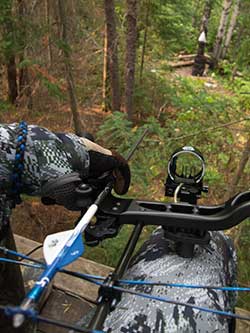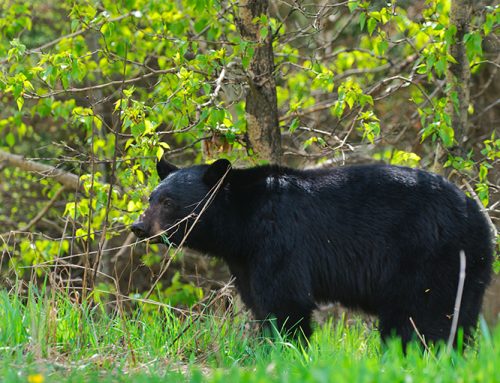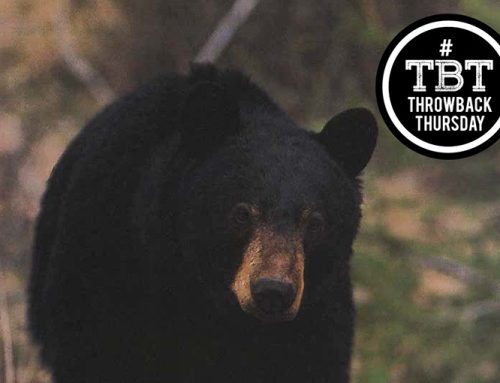
The spring bear pilot hunt is rapidly approaching and, like many, I plan on taking part. I also plan on being prepared. So I talked to Texas MacDonald, an outfitter from McKerrow, Ontario who has been guiding bear hunters for 43 years. Few active bear outfitters in the province have his experience when it comes to hunting bear in spring.
Use an outfitter
One of the first things MacDonald suggested was that new or visiting spring bear hunters book the services of an experienced guide, if they can find one.
“You’ll learn a lot from a good guide,” he said. “More than that, they’ll have scouted and baited prime locations. Baiting is expensive and time consuming, especially if you don’t live in the immediate area of the hunt.”
Related reads
An outfitter can also provide hunters with local knowledge, property to hunt on, and fishing trips to occupy hunters when they’re not on the stand. Outfitters typically process or help process the animal too, as well as help recover it. There’s no better way to learn how to field dress a bear than under the watchful eye of a good guide.
Having said that, MacDonald mentioned that this year some outfitters might not participate in the hunt because there will not be much preparation time once the season is officially approved. More than that, he complained that the exclusion of American hunters means that outfitters will have a hard time getting enough clients to make the spring hunt worthwhile.
“I’m going to guide this spring, should we get the go-ahead, but I would have liked to have had all this confirmed by March,” he said. “That’s when I used to start baiting for a spring hunt.”
If a hide is important to the hunter, it’s best to avoid hunts in late May and early June as bears rub off a lot of hair as the season progresses.
A spring hunt is different
MacDonald notes the spring hunt is in some ways better than the fall hunt. “The thing that amazes me most during the spring hunt is the surprise of seeing a bear come in. The bush is vibrant green, all the poplar trees are leafing out, the grass is bright green, everything is new and clean. And when a bear comes out to the stand, it’s like all of a sudden there is this majestic black beast in front of you.
Perhaps you only looked away for a moment and when you look back again there he is much larger than life. It’s no way as spectacular during the fall hunt when all the colours have turned dull and pastel. The second thing, and high on my priority list, is the fur on the bear is in prime condition and the meat is much leaner to eat,” he said.
If a hide is important to the hunter, it’s best to avoid hunts in late May and early June as bears rub off a lot of hair as the season progresses.
Know the difference
Before collecting the meat and hide, hunters must learn how to identify a legal bear. This is a key skill because, in whatever form the proposed hunt assumes, it will be illegal to kill sows, female bears, with cubs or a cub.
MacDonald says when a bear appears, the hunter should take his or her time and observe it for a while before shooting. This is one reason why baiting provides a definite advantage. Bears visiting sites often stay long enough for the hunter to confirm whether the animal is male or female.
Obviously, a sow is easily identified if cubs accompany her. But sometimes cubs hang back a bit, which is why it is so important to wait until you’re sure.
When uncertain, MacDonald advises the hunter to look for clues around the animal’s genital area. Penis guard hairs are sometimes evident on males. Females that are nursing can sometimes be identified by prominent nipples. Females often have guard hairs sticking out the back between the legs, too.
MacDonald often hangs bait, such as a beaver carcass, high so that bears need to stand to reach it. This gives the hunter a chance at seeing the genital area to confirm gender. He says that a good pair of binoculars is helpful for this.
Determining a bear’s gender strictly by appearance is tricky. Females often seem to have larger ears and narrower snouts, as well as smaller necks and frames, and they’re typically leaner and leggier. The hunter needs to be careful when judging on the basis of this alone, however, because young males can also possess many of these characteristics.
Adult males typically have muscular necks and shoulders, wider, rounder heads and broad snouts that make the ears look smaller. But sometimes large females can be confused with them.
Ultimately, however, the decision to shoot is going to be up to the hunter, so the best advice is don’t take the shot if you are unsure.
The tactics
Aside from hound hunting, which is highly specialized, there are 3 recognized ways to hunt bear: baiting, stalking, and calling.
Baiting
 This is by far the most successful and practical way to hunt bears across most of Ontario. Hunting over bait has many advantages. You hunt places where bear routinely visit and typically get point-blank shot opportunities at a calm animal. You can utilize trail cameras to see what’s coming in. You have a much better chance at determining if the animal is legal to shoot. You are sitting still and waiting silently in ambush for the animal with (hopefully) the wind in your favour.
This is by far the most successful and practical way to hunt bears across most of Ontario. Hunting over bait has many advantages. You hunt places where bear routinely visit and typically get point-blank shot opportunities at a calm animal. You can utilize trail cameras to see what’s coming in. You have a much better chance at determining if the animal is legal to shoot. You are sitting still and waiting silently in ambush for the animal with (hopefully) the wind in your favour.
The down side of baiting is that it takes a lot of work and it can be expensive in terms of bait and gas for your vehicle. It also requires a huge time commitment and is not a good option if you live far away from the baiting site.
“The novice who actually went out and baited faithfully all spring and kept track of the costs of buying the bait and the gas burned and the hours it took would soon realize what a good deal they were getting with the outfitter,” said MacDonald.
Select bait sites as soon as the snow is starting to go. Get your bait sites all set up with trails into them. Then bait twice a week for 2 weeks. After that, bait every second day till about 2 weeks before you plan on hunting. Then, bait every day, says MacDonald.
Of course, you can get away with much less effort but this diminishes chances of success.
Stalking
This technique is possible too, but the chance of success is much slimmer. The advantage is no baiting is required. Typically, the hunter will prowl along cuts, hydro corridors, fields, swamp edges, and anywhere else where bear activity is known to be high. To be successful, the hunter must have good lines of sight to view the animal from a distance and determine if it’s legal to shoot. Finding the right conditions can be difficult during green-up.
Calling is utilized more frequently in the U.S. Essentially, it’s like any other form of predator hunting. It requires that the hunter sets up in relatively open cover in order to see the bear coming, watch its reactions, and identify the animal’s gender. If you don’t have these open vistas, you might be in for a heart-pounding surprise.
The caller tries to mimic a wounded animal to draw bears in. If one responds, it will be hunting whatever made that sound — something that many hunters find disconcerting, especially since you might not legally be able to kill the bear you’ve just teased in.
Running bears with hounds is probably not an option for most of us unless you are part of an established group.
This approach takes less preparation than baiting but the chances of success are not as high. Calling can be combined with hunting over baits or stalking, too. If you are hunting with an outfitter, you should ask their opinion on this first, however. Some prefer to rely solely on their baits.
Running bears with hounds is probably not an option for most of us unless you are part of an established group. It’s still not clear whether hound hunting has any place in the proposed pilot project but MacDonald says the area is not conducive to it anyway, because of private property and Bear Management Area concerns. Gender identification is hard during most chases until the animal is treed, too.
Scent free
Bear possess a remarkable sense of smell, so whichever way you hunt, you should strive to be as scent-free as possible. This is doubly true for bowhunters, who need to close the gap to 25 yards or less.
MacDonald recommends scentless soaps, such as Ivory Snow. Commercial cover scents, scent-free products, and clothing, such as those used when deer hunting or bear hunting in autumn, are also advisable, but the most important thing you can do is situate your stand downwind of the bear’s approach.
Use enough gun
Though bears in spring don’t have the fat layers that they have in fall, they’re still big, muscular animals. That means the hunter has to have a firearm or bow suited to the task.
When it comes to rifles, MacDonald advises hunters use larger calibres with a .270 being the minimum. It’s important that the hunter can comfortably handle the rifle, however, as accuracy is paramount. Shotguns set up to shoot slugs are also poison to bears — 12 gauge being the best choice.
Use enough bow
 He says MNR bowhunting regulations regarding bear, which require 50 pounds pull at 28-inch draw, are adequate, but recommends that a hunter use a heavier bow if they can manage it. When it comes to crossbows, he suggests 150 pound draw weight or better.
He says MNR bowhunting regulations regarding bear, which require 50 pounds pull at 28-inch draw, are adequate, but recommends that a hunter use a heavier bow if they can manage it. When it comes to crossbows, he suggests 150 pound draw weight or better.
MacDonald encourages his hunters to use the heaviest bullet weight for the calibre being used. Rifle shots at bait sites are typically short range, between 25 and 100 yards, but light can be dim when the bears arrives at the bait, so scopes can prove useful.
He’s got definite opinions regarding broadheads, too.
“I like the old solid broadheads or at least solid fixed blade inserts, rather than expanding ones, as they seem to make a cleaner kill and do more damage,” he said.
He advises crossbow shooters to spend time on the range too. “I’ve found over the years the folks who use crossbows don’t actually practice much. The common mythology is if one shot is dead on then they all should be,” he said.
Aside from more practice, he says crossbow users should be able to cock their crossbows on the stand or in the woods unaided. Lastly, it’s prudent for bowhunters to bring a firearm for backup.
Whether using a bow or firearm, the hunter should spend time at the range prior to the hunt to become completely familiar with the tool and their own capabilities. They should also study bear anatomy until they understand the best shot angles. Bears are heavily muscled, so low-angle shots that avoid the shoulder are needed — ideally the near leg is in a forward position to expose more of the vital heart-lung area. If hunting over bait, the hunter should remember to let the bear settle into the bait before taking the shot.
A historic hunt
Like many, I’m hoping to see this majestic game animal slip through the spring woods so that I can collect a nice hide and replenish the freezer.
It’s time to get excited. If all goes as planned, the spring hunt and the bears are about to come out of a long hibernation together.
- Yes (30%)
- Undecided (13%)
- No (57%)
A version of this article first appeared in the April 2014 issue of Ontario OUT OF DOORS magazine, pg. 46 to 52. Subscribe.






I agree with much of what Tex is telling us. Telling a sow from a boar in dim light is VERY hard and cubs may be around so take your time and if in doubt don’t shoot.
So how do you know where you are allowed to set up a bait station?